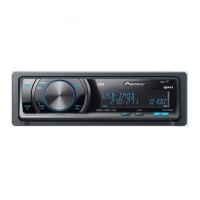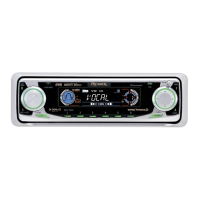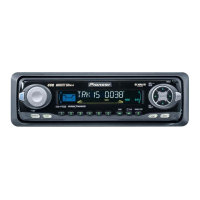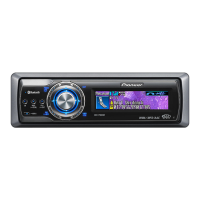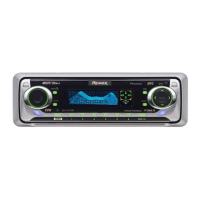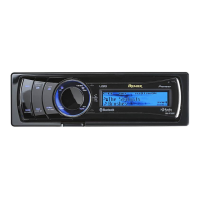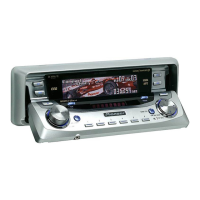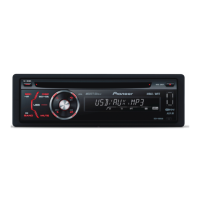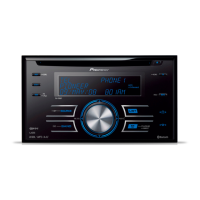
Do you have a question about the Pioneer Premier DEH-P610BT and is the answer not in the manual?
| DIN Size | Single DIN |
|---|---|
| Channels | 4 |
| Bluetooth | Yes |
| HD Radio | No |
| iPod Compatibility | Yes |
| USB Input | Yes |
| AUX Input | Yes |
| Memory Card Slot | No |
| CD Playback | Yes |
| MP3 Playback | Yes |
| WMA Playback | Yes |
| iPod/iPhone Control | Yes |
| Tuner | AM/FM |
| Detachable Faceplate | Yes |
| Remote Control | Yes |
| Max Power Output | 50 Watts x 4 |
| RMS Power Output | 22W x 4 |
| Preamp Voltage | 4 Volts |
Details on FCC and IC compliance, interference, and exposure guidelines for the device.
Confirms compliance of the digital apparatus with Canadian ICES-003 regulations.
Information regarding tuner frequency allocation for North America and potential reception issues.
Guidance on how to use the manual for optimal operation and enjoyment of the unit's features.
Contact information and procedures for obtaining after-sales service and warranty information.
Instructions for product registration and receiving updates on Pioneer products and technologies.
Overview of compatibility with various file formats, media devices, iPod, and hands-free phoning.
Specifies the recommended temperature range for operating the unit.
Details on how to detach the front panel to deter theft and important handling precautions.
Step-by-step instructions on how to detach the front panel from the head unit.
Step-by-step instructions for correctly attaching the front panel to the head unit.
Conditions and procedure for resetting the unit's microprocessor.
Instructions for installing the battery and general care of the remote control.
Guidelines for operating the unit using the remote control, including important handling tips.
Identification and function of buttons and ports on the main unit.
Identification and function of buttons on the remote control.
Explanation of various indicators and symbols displayed on the unit's screen.
Instructions for turning the unit on and off.
How to switch between different audio sources like Tuner, CD, USB, iPod, and Bluetooth.
Guidance on how to adjust the sound level using the MULTI-CONTROL.
How to select bands, perform manual tuning, and seeking tuning.
Steps to easily store and recall up to six broadcast frequencies per band.
Instructions for storing and recalling radio stations using the remote control.
Overview of advanced tuner functions like BSM and local seek tuning.
Automatically store the six strongest broadcast frequencies using BSM.
Enable local seek tuning to tune only to strong radio stations.
How to insert, eject, select tracks, folders, and navigate CDs.
View text information like disc title, artist, and track title for various disc types.
Select a specific track by entering its number using the remote control.
Browse and select tracks from a CD TEXT disc using the track title list.
Browse and select audio files by name from folders on the disc.
Learn about advanced CD player functions like repeat, random, scan, and pause.
Choose to repeat all tracks, the current track, or the current folder.
Play tracks from a selected range in a random order.
Scan the first 10 seconds of each track in a selected range.
Temporarily pause playback and resume it later.
Enhance compressed audio quality for richer sound reproduction.
Store custom titles for up to 48 CDs in the unit's memory.
How to select folders, tracks, fast forward/reverse, and return to the root folder.
View text information for audio files, similar to CD text display.
Select a track directly by entering its number from the USB device.
Browse and select audio files by name from folders on the USB device.
Explore advanced USB functions like repeat, random, scan, and pause.
How to fast forward/reverse, select tracks, and handle iPod operations.
Search for songs by category, making operation and search easy.
Browse songs by playlists, artists, albums, genres, composers, or audiobooks.
Search for songs alphabetically within a selected category.
View text information like song title, artist name, and album title from the iPod.
Learn about advanced iPod functions like repeat, shuffle, and control mode.
Play songs from a selected list in a random order.
Play all songs on the connected iPod in a random order.
Play songs related to the currently playing song by artist, album, or genre.
Control the unit's iPod functions directly from a connected iPod.
Adjust the playback speed for audiobooks on the iPod.
Steps to connect a Bluetooth audio player or telephone to the unit.
Overview of connection functions like pairing, disconnecting, and device management.
Procedure to pair a new Bluetooth device with the unit.
Search for and pair Bluetooth devices from the unit.
How to disconnect an active Bluetooth wireless connection.
Remove a previously paired Bluetooth device from the unit's memory.
Connect to a paired device and select services like PHONE, AVRCP, or A2DP.
Set the unit to automatically connect to a Bluetooth device when in range.
Display system and Bluetooth module versions for troubleshooting.
View the unit's Bluetooth Device (BD) address.
Customize the name of the unit displayed for Bluetooth devices.
Enter or change the PIN code required for Bluetooth device verification.
Information and limitations for using the Bluetooth audio playback feature.
Steps to set up the unit for use with a Bluetooth audio player.
Overview of advanced playback controls for Bluetooth audio.
How to play songs from a connected Bluetooth audio player.
How to stop playback of music from a Bluetooth audio player.
Important notes regarding battery usage and connection standby for Bluetooth telephone.
Steps to set up the unit for hands-free phone calls.
Methods for making phone calls: dialing a number, using phone book, or voice recognition.
Instructions for answering, rejecting, or ending incoming calls.
Manage call waiting, end all calls, switch between callers, or reject waiting calls.
Access and use phone book, missed, dialed, and received call lists.
How to call numbers stored in the synchronized phone book.
Browse and call numbers from recent call history.
Overview of advanced phone functions like phone book transfer and settings.
Transfer phone book entries from a cellular phone to the unit.
Configure the unit to automatically answer incoming calls.
Adjust the other party's listening volume for better speech quality.
Select whether to use the unit's ring tone or not.
Dial a phone number directly using the unit's controls.
Switch to private mode for talking directly on the cellular phone.
Overview of audio adjustment functions available on the unit.
Adjust front/rear and left/right speaker balance for optimal listening.
Adjust equalization to match the car's acoustic characteristics.
Fine-tune factory-supplied equalizer curves by adjusting bands.
Adjust center frequency and Q factor for selected equalizer bands.
Compensate for low/high frequency deficiencies at low volume.
Turn subwoofer output on/off and select phase (normal/reverse).
Set subwoofer cut-off frequency and output level when output is on.
Enable HPF to prevent low frequencies from playing through front/rear speakers.
Boost the bass level of the sound using the bass boost function.
Adjust volume level of each source to prevent radical changes when switching.
Customize system settings for optimal performance.
Choose the display language for the unit's interface.
Adjust the calendar display segments (day, month) for date setting.
Set the unit's clock by adjusting hour and minute segments.
Turn the ignition-off warning tone on or off.
Activate connected auxiliary devices (AUX1, AUX2) individually.
Configure rear output for full-range speakers or subwoofer.
Turn the internal amplifier on or off, recommended when using external amplifiers.
Control continuous scrolling of text information on the display.
Enable or disable the Bluetooth audio player source.
Delete Bluetooth telephone and audio data to protect personal information.
Update the unit's software for the latest features and improvements.
Connect and select up to two auxiliary devices (VCR, portable devices).
Explanation of how auxiliary devices are assigned and connected.
Choose AUX as the audio source if the auxiliary setting is enabled.
Customize the displayed title for AUX sources.
Toggle the clock display on the unit on or off.
Turn the display and button illumination on or off.
Receive notifications for incoming SMS messages on the connected cellular phone.
Control compatible Pioneer external units and their basic operations.
Operate preprogrammed functions for various sources using the PGM button.
Control an optional XM satellite digital tuner, including direct channel selection.
Control an optional SIRIUS satellite radio tuner, including band and channel selection.
Select a SIRIUS channel directly by entering its number.
Store and recall up to six favorite SIRIUS stations.
Overview of advanced SIRIUS tuner functions like mode, game alert, and info.
Choose channel selection by number or category for SIRIUS tuner.
Set alerts for games involving favorite teams from SIRIUS tuner.
Select favorite teams from various leagues for game alerts.
Turn the Game Alert function on or off after team selections.
Switch to the broadcast channel when a selected team's game starts.
View game information and tune to broadcast channels for selected teams.
Display the Radio ID code for HD Radio tuner or SIRIUS tuner.
Operate Instant Replay functions for SIRIUS tuner.
Control an optional HD Radio tuner, including basic operations and display switching.
Overview of advanced HD Radio tuner functions like BSM, seek mode, and blending.
Select seek mode for HD Radio tuner between HD (digital) and ALL (normal).
Enable or disable automatic switching between digital and analog broadcasts.
Control an optional multi-CD player, including basic operations.
Utilize CD TEXT functions with a compatible multi-CD player.
Select a track directly from the multi-CD player.
Explore advanced multi-CD player functions like compression, DBE, and ITS playlists.
Adjust sound quality using compression and dynamic bass emphasis.
Create and play playlists of favorite tracks from the multi-CD player.
Listen to tracks that have been entered into the ITS playlist.
Delete a specific track from your ITS playlist.
Delete all tracks of a CD from your ITS playlist.
Input and display custom titles for CDs in the multi-CD player.
Guides to resolve common issues with Bluetooth, CD player, and USB devices.
Precautions for handling discs and the player to ensure proper performance and longevity.
Information on Dual Discs compatibility and potential playback issues.
Details on supported WMA, MP3, AAC, and WAV file formats and their specifications.
Tips for handling audio files with image data and file naming conventions.
Information on disc file systems, multi-session playback, and compressed audio disc playback.
Guidelines and compatibility information for USB audio players and memory devices.
Illustrates a typical folder and file hierarchy for audio files.
Information on how folder numbers are assigned and file playback sequence.
How audio file sequence is determined for USB memory devices.
Lists supported iPod models and software versions.
Precautions for handling the iPod, including temperature and secure placement.
How unit settings affect iPod EQ and repeat functions.
Lists Bluetooth profiles supported by the unit for wireless technology.
Legal notices regarding WMA, MP3, Bluetooth, iPod, iPhone, iTunes, and SAT Radio.
Technical specifications for power source, dimensions, and weight.
Audio output specifications including power, impedance, preout, equalizer, and subwoofer settings.
Technical specifications for the CD player, including disc compatibility and signal-to-noise ratio.
Technical specifications for USB connectivity, including standard, current, and file system.
Technical specifications for the FM tuner, including frequency range and sensitivity.
Technical specifications for the AM tuner, including frequency range and sensitivity.
Technical specifications for Bluetooth connectivity, including version and output power.
Power output and S/N ratio specifications according to CEA-2006 standards.

